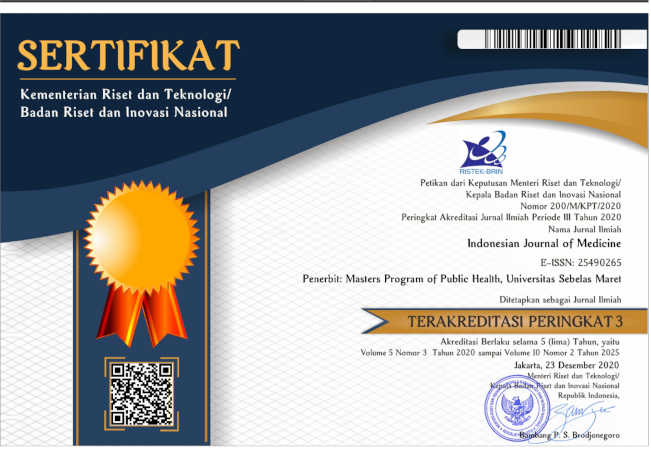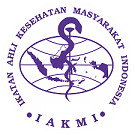Paraspinal Abscess Secondary to Spondylodiscitis: A Rare Presentation with Progressive Neurological Deficits and Systemic Infection
DOI:
https://doi.org/10.26911/theijmed.2025.10.2.842Abstract
Background: Spondylodiscitis is a rare but serious spinal infection that may result in neuro-logical and systemic complications, especially when associated with paraspinal abscess formation. This case highlights its clinical severity and the importance of early intervention. This study aims to highlight the clinical importance and potential severity of spondylodiscitis, particularly when complicated by paraspinal abscess formation.
Case Presentation: A patient presented with progressive lower back pain, bilateral lower limb weakness, and systemic symptoms including fever and night sweats. Laboratory tests revealed hypoalbuminemia, leukocytosis, and anemia. MRI imaging identified a paraspinal abscess at the L3–L5 levels, resulting in lumbar canal stenosis and worsening neurological deficits. Emergency surgical intervention was undertaken, consisting of abscess drainage, laminectomy for neural decompression, and posterior spinal stabilization. Intraoperative findings included a substantial purulent collection, necessitating extensive debridement. Postoperatively, the patient demonstra¬ted clinical improvement with ongoing antibiotic therapy, nutritional support, and rehabilitation.
Discussion: Spondylodiscitis with paraspinal abscess is a diagnostic challenge due to its insidious onset and non-specific presentation. Delayed recognition increases the risk of severe neurological impairment and systemic sepsis. MRI is the gold standard for early detection, while micro¬biological confirmation is crucial for targeted treatment. A multidisciplinary approach is essential. Surgical intervention is indicated for progressive neurological deficits, extensive abscess formation, or spinal instability, with timely antibiotic therapy playing a critical role in infection control.
Conclusion: This case illustrates the importance of early diagnosis and timely surgical manage-ment in spondylodiscitis with paraspinal abscess. Multimodal treatment improves outcomes and helps prevent long-term disability.
Keywords:
neurological deficit, Spondylodiscitis, spinal stabilization, paraspinal abscessReferences
Pant A, Prasai A, Rauniyar AK, Adhikary L, Basnet K, Khadka T (2021). Pneumonia in patients with chronic kidney disease admitted to nephro-logy department of a tertiary care center: A descriptive cross- sectional study. JNMA J Nepal Med Assoc. 59(242): 1000-1003. https://doi.org/10.31729/jnma.7074.
Basodan N, Al Mehmadi AE, Al-Mehmadi AE, Aldawood SM, Hawsawi A, Fatini F, et al. (2022). Septic shock: Mana-gement and outcomes. Cureus, 14(12): e32158. https://doi.org/10.7759/cu-reus.32158.
Bauer M, Gerlach H, Vogelmann T, Preiss-ing F, Stiefel J, Adam D (2020). Mor-tality in sepsis and septic shock in Europe, North America and Australia between 2009 and 2019-results from a systematic review and meta-analy-sis. Crit Care, 24(1):239. https://doi-.org/10.1186/s13054-020-02950-2.
Delgado C, Baweja M, Crews DC, Eneanya ND, Gadegbeku CA, Inker LA, Mendu, et al (2022). A unifying approach for GFR estimation: Recommendations of the NKF-ASN task force on reassessing the inclusion of race in diagnosing kidney disease. J Am Soc Nephrol. 79(2): 268-288. https://doi.org/10.-1681/asn.2021070988.
Fleischmann-Struzek C, Rudd K (2023). Challenges of assessing the burden of sepsis. Med Klin Intensivmed Notf-med. 118(2): 68-74. https://doi.org/-10.1007/s00063-023-01088-7.
Franquet T (2018). Imaging of community-acquired pneumonia. J Thorac Imag-ing. 33(5): 282–294. https://-doi.org/-10.1097/rti.0000000000000347.
Fulton MR, Zubair M, Taghavi S (2025). Laboratory evaluation of sepsis. In Statpearls, Statpearls Publishing. https://www.ncbi.nlm.nih.gov/books/NBK594258/
Gheit Y, Gheit IS, Ierulli J, Mbaga I (2023). Rare case of gout leading to septic arthritis, osteomyelitis, and septic shock in an elderly patient. Cureus. 15(11): e48836. https://doi.org/10.7-759/cureus.48836.
Guarino M, Perna B, Cesaro AE, Maritati M, Spampinato MD, Contini C, De Giorgio R (2023). 2023 update on sepsis and septic shock in adult pati-ents: Management in the emergency department. J Clin Med. 12(9): 3188. https://doi.org/10.3390/jcm12093188.
Hill-McManus D, Soto E, Marshall S, Lane S, Hughes D (2018). Impact of non-adherence on the safety and efficacy of uric acid-lowering therapies in the treatment of gout. Br J Clin Pharma-col. 84(1): 142–152. https://doi.org/-10.1111/bcp.13427.
Hotchkiss RS, Moldawer LL, Opal SM, Reinhart K, Turnbull IR, Vincent JL (2016). Sepsis and septic shock. Nat Rev Dis Primers. 2: 16045. https://-doi.org/10.1038/nrdp.2016.45.
Ilg A, Moskowitz A, Konanki V, Patel PV, Chase M, Grossestreuer AV, Donnino MW. (2019). Performance of the CURB-65 score in predicting critical care interventions in patients admitted with community-acquired pneumonia. Ann Emerg Med. 74(1): 60–68. https://doi.org/10.1016/j.an-nemergmed.2018.06.017.
Lee TH, Chen JJ, Wu CY, Yang CW, Yang HY (2021). Hyperuricemia and pro-gression of chronic kidney disease: A review from physiology and pathoge-nesis to the role of urate-lowering therapy. Diagnostics (Basel). 11(9): 1674. https://doi.org/10.3390/diag-nostics11091674.
Mahadita GW, Suwitra K. (2021). The role of hyperuricemia in the pathogenesis and progressivity of chronic kidney disease.
Maced J Med Sci. 9(F): 428–435. https://doi.org/10.3889/-oamjms.2021.7100.
Martin GS (2012). Sepsis, severe sepsis and septic shock: Changes in incidence, pathogens and outcomes. Expert Rev Anti Infect. 10(6): 701–706. https://-doi.org/10.1586/eri.12.50.
Rice JB, White AG, Scarpati LM, Wan G, Nelson WW (2017). Long-term syste-mic corticosteroid exposure: A syste-matic literature review. Clin Ther. 39(11): 2216–2229. https://doi.org/-10.1016/j.clinthera.2017.09.011.
Roughley MJ, Belcher J, Mallen CD, Roddy E (2015). Gout and risk of chronic kidney disease and nephrolithiasis: Meta-analysis of observational studies. Arthritis Res Ther, 17(1):90. https://doi.org/10.1186/s13075-015-0610-9.
Srzić I, Adam VN, Pejak DT (2022). Sepsis definition: What’s new in the treat-ment guidelines. Acta Clin Croat. 61(1): 67–72. https://doi.org/10.204-71/acc.2022.61.s1.11.
Sun GD, Zhang Y, Mo SS, Zhao MY (2021). Multiple organ dysfunction syndrome caused by sepsis: Risk factor analysis. Int J Gen Med, 14: 7159–7164. https:-//doi.org/10.2147/IJGM.S328419.
Zhuang T, Eppler SL, Shapiro LM, Roe AK, Yao J, Kamal RN. (2021). Financial distress is associated with delay in seeking care for hand conditions. Hand (N Y). 16(4): 511–518. https://-doi.org/10.1177/1558944719866889.












